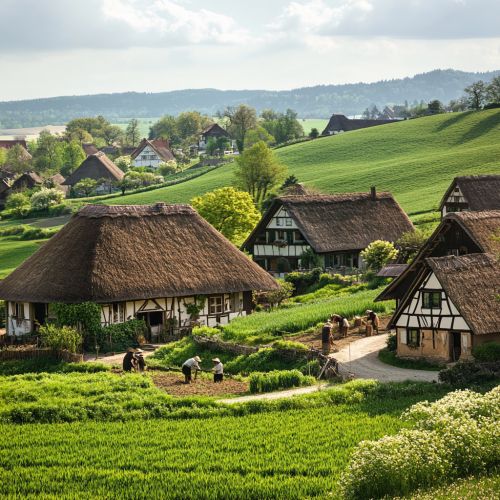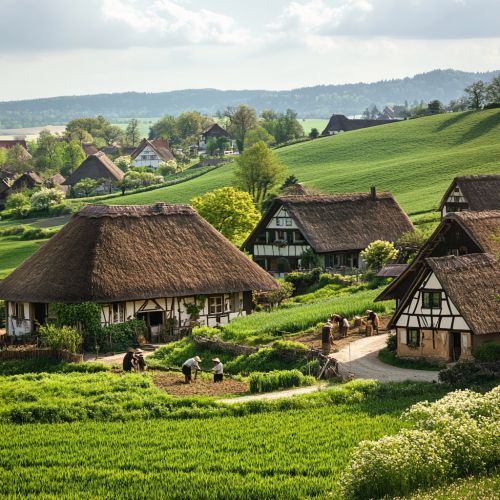Village Life
Introduction
Village life represents a way of living that is distinct from urban life, characterized by a close-knit community, traditional practices, and a reliance on agriculture and natural resources. This article delves into the various aspects of village life, exploring its socio-economic structures, cultural practices, and the challenges and benefits associated with living in rural areas.
Historical Context
Village life has been the predominant form of human settlement for thousands of years. The Neolithic Revolution, which began around 10,000 BCE, marked the transition from nomadic hunter-gatherer societies to settled agricultural communities. Villages emerged as people began to cultivate land and domesticate animals, leading to the development of more complex social structures and economies.
Socio-Economic Structures
Village economies are typically based on subsistence agriculture, where families grow crops and raise livestock primarily for their own consumption. This form of agriculture often involves the use of traditional farming techniques, such as crop rotation and the use of organic fertilizers.
Land Ownership and Tenure
Land ownership in villages can vary widely, from communal land systems to private ownership. In many traditional societies, land is held collectively by the community or clan, with individual families having rights to use specific plots. This system can promote social cohesion but may also lead to conflicts over land use and inheritance.
Labor and Employment
Labor in villages is often divided along gender and age lines, with men typically engaged in heavy agricultural work and women responsible for domestic tasks and light farming activities. Children often contribute to the family's labor needs from a young age, helping with tasks such as herding animals or fetching water.
Cultural Practices
Village life is rich in cultural traditions and practices that have been passed down through generations. These traditions often revolve around agricultural cycles, religious beliefs, and community events.
Festivals and Celebrations
Festivals in villages are usually tied to the agricultural calendar, celebrating events such as planting and harvest seasons. These festivals often involve communal feasting, music, dance, and religious rituals. For example, the Harvest Festival is a common celebration in many cultures, marking the end of the harvest season with thanksgiving and festivities.
Social Hierarchies and Roles
Villages often have well-defined social hierarchies and roles, with elders and community leaders holding significant authority. These leaders may be responsible for resolving disputes, organizing communal activities, and maintaining cultural traditions. Social roles can also be influenced by factors such as caste, clan, or family lineage.
Daily Life and Activities
The daily life of villagers revolves around agricultural activities, household chores, and community interactions. The pace of life is generally slower compared to urban areas, with a strong emphasis on communal living and mutual support.
Agricultural Activities
Agriculture is the backbone of village life, with most villagers engaged in farming or related activities. Common crops include grains, vegetables, and fruits, while livestock such as cows, goats, and chickens are raised for milk, meat, and eggs. Agricultural activities are often seasonal, with distinct periods for planting, tending, and harvesting crops.


Household Chores
Household chores in villages are typically labor-intensive and time-consuming. Tasks such as fetching water, collecting firewood, cooking, and cleaning are often performed manually, without the aid of modern appliances. Women usually bear the brunt of these chores, although men and children also contribute.
Community Interactions
Community interactions are a vital part of village life, with villagers frequently coming together for social, religious, and economic activities. Communal spaces such as village squares, markets, and temples serve as important venues for these interactions. Social bonds are strengthened through mutual aid and cooperation, with villagers often helping each other during times of need.
Education and Health
Access to education and healthcare in villages can be limited, with significant disparities compared to urban areas. However, efforts are being made to improve these services and bridge the gap between rural and urban communities.
Education
Educational facilities in villages are often basic, with limited resources and infrastructure. Schools may lack trained teachers, textbooks, and other essential materials. Despite these challenges, education is highly valued, and many villages have community-driven initiatives to promote literacy and learning. Non-governmental organizations (NGOs) and government programs also play a crucial role in improving rural education.
Health
Healthcare services in villages are often rudimentary, with a shortage of medical professionals and facilities. Traditional medicine and home remedies are commonly used to treat illnesses, although access to modern healthcare is gradually improving. Public health initiatives, such as vaccination campaigns and health education programs, are essential in addressing common health issues and promoting overall well-being.
Challenges and Benefits
Village life presents a unique set of challenges and benefits, shaped by the interplay of environmental, social, and economic factors.
Challenges
One of the primary challenges of village life is the lack of infrastructure and services. Villages may have limited access to clean water, sanitation, electricity, and transportation, which can hinder development and quality of life. Additionally, rural areas are often more vulnerable to environmental hazards such as droughts, floods, and soil degradation.
Economic opportunities in villages are also limited, with many villagers relying on subsistence farming and informal labor. This can lead to poverty and food insecurity, particularly during times of crop failure or economic downturn. Migration to urban areas in search of better opportunities is a common response to these challenges, although it can result in the depopulation and decline of rural communities.
Benefits
Despite these challenges, village life offers several benefits that are often lacking in urban environments. The close-knit nature of village communities fosters strong social bonds and a sense of belonging. The slower pace of life and connection to nature can also contribute to a higher quality of life and well-being.
Village life is often characterized by a high degree of self-sufficiency and sustainability. Traditional farming practices and local knowledge play a crucial role in managing natural resources and preserving biodiversity. Additionally, the cultural heritage and traditions of village communities are valuable assets that contribute to the diversity and richness of human civilization.
Modern Transformations
Village life is undergoing significant transformations due to various factors, including globalization, technological advancements, and government policies. These changes are reshaping the socio-economic landscape of rural areas and influencing the way villagers live and interact.
Technological Advancements
The introduction of modern technologies, such as mobile phones, the internet, and mechanized farming equipment, is transforming village life. These technologies are improving access to information, markets, and services, enabling villagers to enhance their productivity and quality of life. For example, mobile banking and digital payment systems are providing new financial opportunities for rural communities.
Government Policies and Programs
Government policies and programs aimed at rural development are playing a crucial role in improving infrastructure, education, healthcare, and economic opportunities in villages. Initiatives such as rural electrification, road construction, and agricultural subsidies are helping to bridge the gap between rural and urban areas. Additionally, social welfare programs are providing support to vulnerable populations, such as elderly villagers and low-income families.
Migration and Urbanization
Migration from villages to urban areas is a significant trend, driven by the search for better economic opportunities and living conditions. This migration can have both positive and negative impacts on village life. On one hand, remittances from migrants can provide much-needed financial support to rural families. On the other hand, the loss of young and skilled individuals can lead to labor shortages and the decline of traditional practices.
Conclusion
Village life is a complex and multifaceted phenomenon, shaped by historical, socio-economic, and cultural factors. While it presents unique challenges, it also offers valuable benefits and opportunities for sustainable living and community cohesion. As villages continue to evolve in response to modern transformations, it is essential to preserve their cultural heritage and promote inclusive development that benefits all members of rural communities.
